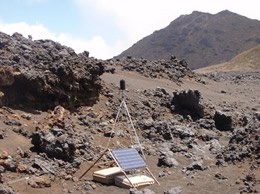Last updated: February 9, 2018
Article
Mitigating the Impacts of Aviation

A variety of aircraft, including NPS-operated, military, commercial, and general aviation, fly in the airspace over national parks. Although there are many legitimate aviation uses, overflights can adversely affect park resources and values and interfere with visitor enjoyment.
The Natural Sounds and Night Skies Division helps parks manage sounds in a way that balances the various expectations of park visitors with the protection of park resources. Park sounds are part of a web of resources that the National Park Service protects under the Organic Act. From the mysterious calls of bugling elk in mountains to the patriotic calls of trumpeting bugles across a historic battlefield, the NPS invites its visitors to experience our parks through this world of sound. The division works in partnership with parks and others to increase scientific understanding and inspire public appreciation of the value and character of "soundscapes" - the human perception of acoustical environments that express each park's unique qualities.
Air Tours
The NPS works cooperatively with the Federal Aviation Administration (FAA) and air tour operators to develop air tour management agreements for parks where air tours are occurring or are proposed. The agreements are designed to protect park resources and visitor use without compromising aviation safety or the nation's air traffic control system. They establish conditions for conducting air tours, including specific routes, altitudes, number of flights, type of aircraft, hours of operations, and reporting requirements.
To learn more about air tour management agreements, please visit the Natural Sounds and Night Skies Division Overflights Air Tours page.
Additional Laws and Policies
Because the nation’s airspace is managed by the FAA, the NPS works constructively and cooperatively with the FAA, national defense, and other agencies to ensure that authorized aviation activities affecting units of the national park system occur in a safe manner and do not cause unacceptable impacts to park resources and values and visitor experiences. Cooperation is essential because the other agencies involved have statutory authorities and responsibilities that are recognized by NPS. (Management Policies, Overflights and Aviation Use, Chap. 8.4)
FAA Advisory Circular 91-36D Visual Flight Rules (VFR) Flight Near Noise-Sensitive Areas
Advisory regarding flights over charted National Park Service areas, U.S. Fish and Wildlife Service areas, or U.S. Forest Service areas.
All aircraft are requested to maintain a minimum altitude of 2,000 feet above the surface of lands and waters administered by the NPS, UFWS, or USFS Wilderness areas. Since excessive aircraft noise can result in annoyance, inconvenience or interference with the uses and enjoyment of parks where a quiet setting is a generally recognized feature or attribute (including areas with wilderness characteristics), and can adversely affect wildlife in areas, all aircraft are requested to fly at altitudes higher than the minimum permitted by regulation. FAA receives complaints concerning low flying aircraft over noise sensitive areas and requests pilots to adhere to the voluntary practices set forth in the Advisory Circular.
Information Regarding Flight Advisories in National Parks
Landing at national parks, monuments, preserves, and wildlife refuges, and at state refuges, critical habitat areas, and sanctuaries.
